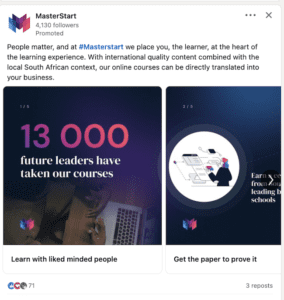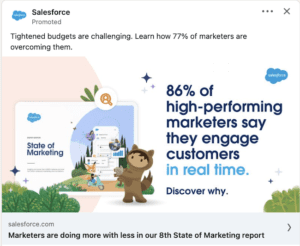LinkedIn has established itself as a powerhouse in the B2B space, offering a unique platform to connect with professionals, decision-makers, and potential clients in a highly targeted manner. Today, we’ll explore the ins and outs of LinkedIn advertising and provide you with practical tips to create ads that truly stand out and deliver results.
Let’s back up the claims with some statistics. Studies have shown that LinkedIn generates more than 80% of B2B leads from social media, making it a goldmine for businesses seeking quality leads. Moreover, LinkedIn users are generally more engaged and open to exploring business opportunities, which translates into higher conversion rates for your ads.
Throughout this article, we’ll equip you with the knowledge and strategies to create LinkedIn ads that grab attention, resonate with your target audience, and ultimately drive those all-important conversions. Whether you’re a small business owner, a startup founder, or an entrepreneur looking to make a splash in the B2B arena, this one’s for you.
With over 774 million professionals actively using the platform, LinkedIn provides a vast pool of potential leads and clients who are actively seeking business opportunities. Whether you’re targeting specific industries, job titles, or company sizes, LinkedIn offers precise targeting options that enable you to reach the right people at the right time.
What sets LinkedIn apart from other social media platforms is its professional nature. Users come to LinkedIn with a mindset focused on career growth, networking, and industry insights. This mindset creates an environment that is conducive to B2B interactions and makes users more receptive to business-related content, including ads. By leveraging this context, your LinkedIn ads have a higher chance of capturing attention, resonating with your target audience, and driving meaningful engagement.
Additionally, LinkedIn offers various ad formats and targeting options to suit your specific goals. Whether you want to drive traffic to your website, generate leads, or promote your brand, LinkedIn provides the tools to tailor your ad campaigns accordingly. From sponsored content and dynamic ads to message ads and video ads, you can choose the format that best aligns with your objectives and resonates with your target audience.
Now that we understand the power of LinkedIn advertising for B2B businesses, it’s time to roll up our sleeves and set up your LinkedIn advertising campaign. Let’s walk through the essential steps to ensure your campaign is well-planned and poised for success.
Define your goals and objectives
Start by clarifying your advertising goals. Are you looking to increase brand awareness, generate leads, drive website traffic, or promote a specific product or service? By clearly defining your objectives, you can align your campaign strategy and measure success effectively.
Identify your target audience on LinkedIn
LinkedIn’s advanced targeting options allow you to reach specific professionals who are most likely to be interested in your offerings. Consider factors such as industry, job title, company size, location, and more. By narrowing down your target audience, you can maximise the relevance and impact of your ads.
Consider this ad targeting learners who may be searching for courses and furthering their knowledge base.

Choose the right ad format
LinkedIn offers a range of ad formats to suit different campaign objectives. Consider the strengths and suitability of each format. Sponsored content enables you to promote your posts within users’ feeds, while message ads allow personalised one-to-one communication. Video ads can capture attention and deliver engaging content, and dynamic ads can be tailored dynamically to resonate with your audience.
Set a budget and schedule
Determine your advertising budget based on your campaign goals and overall marketing strategy. LinkedIn offers flexible budgeting options, allowing you to set daily or total campaign budgets. Additionally, consider the duration and timing of your campaign, aligning it with your audience’s online activity and any specific events or promotions.
By carefully considering these factors and making informed decisions, you’ll lay a strong foundation for your LinkedIn advertising campaign. Remember, planning and preparation are key to achieving the desired outcomes.
Let’s talk about the anatomy of a successful LinkedIn ad. Picture this: a captivating headline that piques curiosity, followed by concise and compelling ad copy that clearly communicates your value proposition. And don’t forget to sprinkle in some relevant keywords to ensure your ad shows up in the right searches. To make your ads visually appealing, incorporate eye-catching images or even consider using videos that tell a story or demonstrate your product/service in action.
This visually appealing ad is eye-catching and engaging, drawing users into its proposition.

When writing your headlines and ad copy, keep in mind that LinkedIn users are professionals looking for solutions and valuable insights. Make it clear how your product or service can address their pain points or help them achieve their goals. Use concise language, avoiding jargon or complex terminology that may confuse your audience. Remember, simplicity and clarity are key to engaging busy professionals.
As depicted here. The simple yet informative style provides all the information that is required to encourage engagement.

One powerful technique to make your ads stand out is personalisation. LinkedIn allows you to tailor your ads based on specific attributes of your target audience. Address your audience directly by using “you” and “your” in your copy. Show them that you understand their needs and offer a solution that is tailored to them. Personalisation goes a long way in building trust and establishing a connection with your audience.
Speaking of trust, incorporating social proof in your ads can make a significant impact. Showcase testimonials, endorsements, or success stories from satisfied customers to build credibility and demonstrate the value you bring. People are more likely to trust recommendations from their peers, so leverage the power of social proof to boost the effectiveness of your ads.
Another crucial element of a compelling LinkedIn ad is a clear and compelling call-to-action (CTA). Prompt your audience to take the desired action, whether it’s signing up for a free trial, downloading a whitepaper, or contacting your sales team. Make your CTA stand out by using action-oriented words and creating a sense of urgency. Encourage your audience to act now and not miss out on the opportunity you’re presenting.
Lastly, don’t forget to take advantage of LinkedIn’s interactive features. Use polls, quizzes, or surveys to engage your audience and encourage their participation. Interactive content can increase engagement and provide valuable insights into your audience’s preferences.
With these tips in mind, you’re well on your way to creating compelling LinkedIn ads that capture attention, resonate with your audience, and drive action.
Ensuring your hard-earned ad expenditure is being put to good use is the next step. Here are some essential tips to optimise your LinkedIn ads and turn those clicks into conversions.
First things first, let’s talk about your landing pages. A well-designed and optimised landing page can make all the difference in converting those ad clicks into valuable leads or sales. Ensure that your landing page aligns seamlessly with your ad’s messaging and offers a clear and compelling value proposition. Keep the design clean, the content concise, and the call-to-action (CTA) prominent. Make it as easy as possible for your audience to take the desired action without any distractions.
To measure the success of your LinkedIn ads and optimise for conversions, conversion tracking is a must. Set up conversion tracking on your website to understand how well your ads are performing in terms of driving specific actions, such as form submissions, purchases, or downloads. This valuable data will enable you to make informed decisions about your ad campaigns and identify areas for improvement.
A/B testing is another powerful technique to optimise your LinkedIn ads. Create multiple versions of your ads and test them against each other to see which performs better. You can experiment with different headlines, ad copy variations, images, or CTAs. By testing and refining your ads, you can uncover the winning combination that resonates most with your audience and drives higher conversion rates.
While you’re optimising, keep a close eye on LinkedIn’s ad analytics and insights. Dive into the performance metrics, such as click-through rates, engagement rates, and conversion rates, to gain valuable insights into how your ads are performing. Identify any patterns or trends and use that information to make data-driven decisions for your future ad campaigns.
Scaling up successful campaigns is another key strategy for optimisation. Once you’ve identified a winning formula, consider expanding your reach and budget to maximise the impact. LinkedIn offers options to scale your campaigns and reach a broader audience while maintaining the same level of targeting precision that makes the platform so effective.
By implementing these optimisation strategies, you’ll be well on your way to driving higher conversions from your LinkedIn ads.
LinkedIn advertising presents a unique opportunity to connect with a highly targeted audience and build meaningful relationships with B2B professionals in your industry. By leveraging the platform’s advanced targeting options, personalisation features, and robust analytics, you can tailor your ads to resonate with them and achieve your marketing goals.
As a small business owner or entrepreneur, investing time, effort, and resources into creating strategic and engaging ads can drive brand awareness, generate high-quality leads, and ultimately boost your bottom line. Remember, don’t be afraid to experiment, test different strategies, and optimise your campaigns based on real-time data. The key is to stay agile, adapt to the changing landscape, and continuously refine your approach for optimal results. And if you need a hand, we’re here to help.